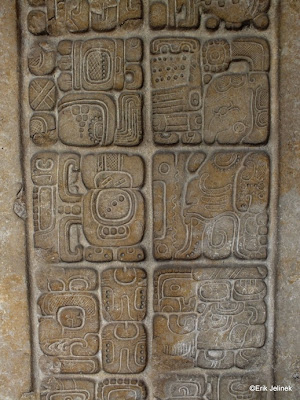Ever since leaving Peru and its rich archaeological heritage the historical remains on offer have been somewhat underwhelming. All that has changed now that I've reached Honduras and El Salvador, whose western edges mark the easternmost limits of the Mayan empire. Of the "Big 3" indigenous American civilisations (from north to south the Aztec, Maya and Inca) the Maya are undoubtedly preeminent both in terms of longevity and cultural achievements. The Maya first appeared around 2000 B.C., were still around when the Spanish conquered the Americas, and are still here today (although not doing human sacrifices anymore). The Aztecs and Incas by comparison were mere flashes in the pan, existing for no more than a couple of centuries, and whose culture has almost completely disappeared today.
 |
| Spotting the main temple complex of Copan through the trees. |
The town of Copan Ruinas was not named by the most imaginative of people, being situated as it is just beside the ancient ruins of Copan, one of the major Mayan cities of the late classic period (around 500-800 AD). Although perhaps not as grand as Tikal or Palenque, nevertheless the are the requisite pyramids, stelae and ball courts. I particularly love the jungle setting with fig trees and their enveloping roots sprouting from atop pyramids and temples. From an archaeological perspective Copan is special because of its wealth of glyphs, the most of any Mayan site, that helped decipher the complex Mayan writing system with its intricate glyphs. Not only were they the only American civilisation to develop a writing system, but they were also master astrologers and mathematicians, able to predict eclipses and even calculated the length of the year with far greater precision than their European contemporaries.
 |
| The funky glyphs that comprise the Mayan writing system. Frankly I'm amazed they managed to decipher them at all. |
Just as important for our knowledge of the Mayan world, but for very different reasons, is the site of Joya de Ceren in El Salvador. Here there are no pyramids, opulent graves or majestic stelae. Instead Joya was a simple farming village of no particular consequence until the year 590 AD when a small, nearby volcano erupted, spewing forth copious amounts of ash, causing the populace to flee and burying the village in a preserving layer of ash several metres thick. The tourist brochure eulogises it as the Pompeii of the Americas, which is perhaps too generous, but the perfect preservation of everyday utensils, houses, food and even the duck tied to the kitchen doorpost ready for the dinner pot, has allowed scholars to piece together aspects of everyday life for ordinary Mayans, rather than just the kings and high priests.
 |
| The protected archaeological remains of Joya de Ceren with its simple houses that were wonderfully preserved by multiple layers of volcanic ash. |
When the Europeans came to Central America the Mayans were there, but they no longer lived in the grandiose cities that had flourished centuries earlier. For reasons that are not entirely clear, and over which there is much heated debate in the world of archaeology, (long-lasting drought, excessive human pressures on the environment leading to agricultural collapse, internal crises, or some combination of the above) the 9th and 10th centuries saw a dramatic collapse in the Mayan civilisation: the huge cities were abandoned, much of the knowledge was lost and the Maya splintered into smaller polities and had to contend with the influx of other peoples from regions of Central America.
 |
| The great Mayan cities were abandoned some time in the 10th century and were quickly reclaimed by the forest. |
It is these other peoples that now form the basis of the indigenous and mestizo populations of Honduras and El Salvador, having more in common to the Nahua of Central Mexico. This is most evident in the local food that has slowly transformed from the rice and beans of Nicaragua and Costa Rica to a more tortilla-based subsistence, exemplified by pupusas, the national dish of both El Salvador and Honduras (although as is common in the petty nationalisms of young, post-colonial countries, each claims it as its own - and woe betide should you suggest to a Salvadorean that his beloved pupusas are, in fact, Honduran), a tasty, fat tortilla filled with any combination of cheese, beans or meat and served with as much pickled vegetables as you can stomach. It remains one of the greatest mysteries to me that such young nations, created arbitrarily and having many common traits with each other, can manage to foster such enmity. Throughout Latin America there are petty state rivalries and animosities: Nicaragua and Costa Rica, Venezuela and Colombia, Bolivia and Chile, and El Salvador and Honduras. The latter pair even went to war (for 100 hours) back in 1969 after a particularly acrimonious football match, in what became known as the Football War.
 |
| The growing ubiquity of tortillas, and the soft clapping as the flour is moulded into shape between deft hands, is a clear indication that you are getting ever closer to Mexico. |
No comments:
Post a Comment